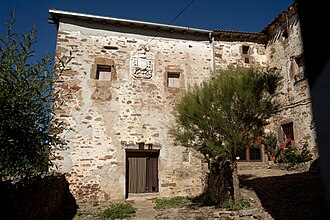Oncala
| Oncala parish | ||
|---|---|---|
 Oncala - town view with church
|
||
| coat of arms | Map of Spain | |

|
|
|
| Basic data | ||
| Autonomous Community : |
|
|
| Province : | Soria | |
| Comarca : | Tierras Altas (Soria) | |
| Coordinates | 41 ° 58 ′ N , 2 ° 19 ′ W | |
| Height : | 1285 msnm | |
| Area : | 39.92 km² | |
| Residents : | 75 (Jan. 1, 2019) | |
| Population density : | 1.88 inhabitants / km² | |
| Postal code : | 42172 | |
| Municipality number ( INE ): | 42135 | |
| administration | ||
| Website : | Oncala | |
Oncala is a village and one of the main village and three hamlets (Pedanías) existing municipality ( municipio ) with a total of 75 inhabitants (at January 1, 2019) in the northern Spanish province of Soria in the autonomous community of Castile and Leon .
location
The place Oncala is in the headwaters of the Río Linares , a tributary of the Ebro , about 35 km (driving distance) northeast of the provincial capital Soria in the Iberian Mountains at an altitude of about 1285 m above sea level. d. The climate in winter is cool, but in summer it is quite pleasant; The precipitation, which is quite high for the region (approx. 690 mm / year), falls - with the exception of the rather poorly rainy summer months - distributed throughout the year.
Population development
| year | 1900 | 1950 | 2000 | 2016 |
| Residents | 246 | 239 | 106 | 75 |
The significant population decline in the 20th century is mainly due to the mechanization of agriculture and the associated loss of jobs.
economy
In the Middle Ages, small traders, craftsmen and service providers of all kinds also settled in the rural community, which was mainly characterized by cattle breeding and largely self-sufficient. Since the 1970s tourism has developed into an important source of income in the form of the rental of holiday homes (casas rurales) .
history
No news is known from ancient or medieval times. In the past, the high-altitude and therefore almost always green area was visited by migrant shepherds with their herds of goats and sheep in the summer months . The place developed only very gradually; whose church was not built until the end of the 18th century as a result of a foundation.
Attractions
- Many of the town's houses have exposed quarry stone facades. A stone coat of arms is emblazoned above the portal of one of the houses .
- The Iglesia de San Millán is dedicated to St. Aemilianus of Cogolla , the patron saint of the shepherds, and stands on the highest point of the place. On some days, a series of 10 tapestries made in Flanders in the 17th century, based on designs by Peter Paul Rubens, hangs on the outer walls of the rather simple nave . The church itself and the tapestries were donated by a bishop who was born in Oncala in the late 18th century.
- A museum deals with the tradition of transhumance.
- Surroundings
- There are two hermit churches (Ermita de la Virgen del Espino and Ermita de San Pedro del Haya) in the municipality .
Web links
- Oncala, sights - photos + information (Spanish)
Individual evidence
- ↑ Cifras oficiales de población resultantes de la revisión del Padrón municipal a 1 de enero . Population statistics from the Instituto Nacional de Estadística (population update).
- ↑ Oncala - Map with altitude information
- ↑ Oncala - climate tables
- ↑ Oncala - Population Development
- ↑ Oncala - History ( Memento of the original dated November 7, 2017 in the Internet Archive ) Info: The archive link was inserted automatically and has not yet been checked. Please check the original and archive link according to the instructions and then remove this notice.
- ↑ Oncala - Church
- ↑ Oncala - Museo
- ↑ Oncala - Ermita de la Virgen del Espino
- ↑ Oncala - Ermita de San Pedro del Haya

